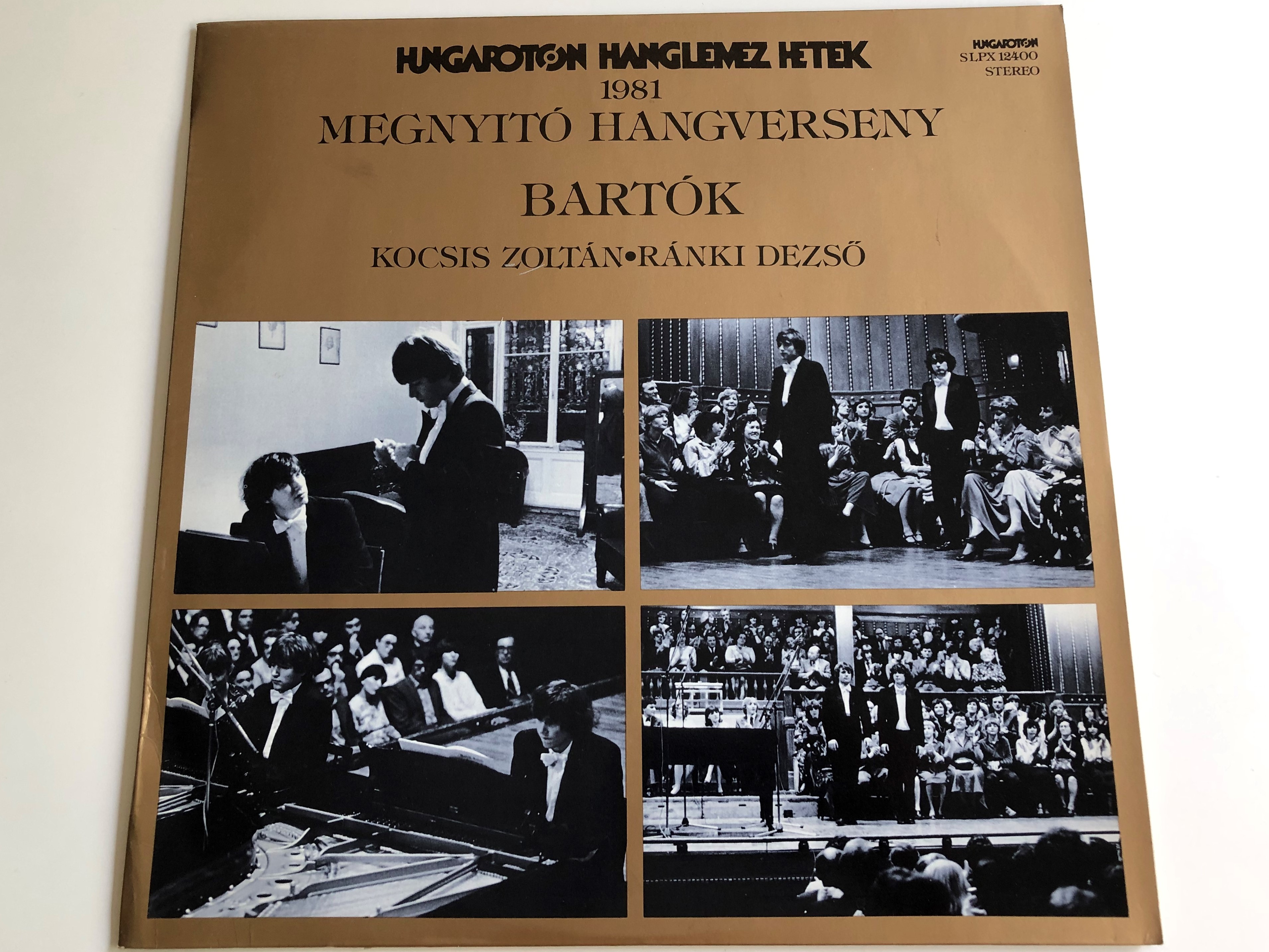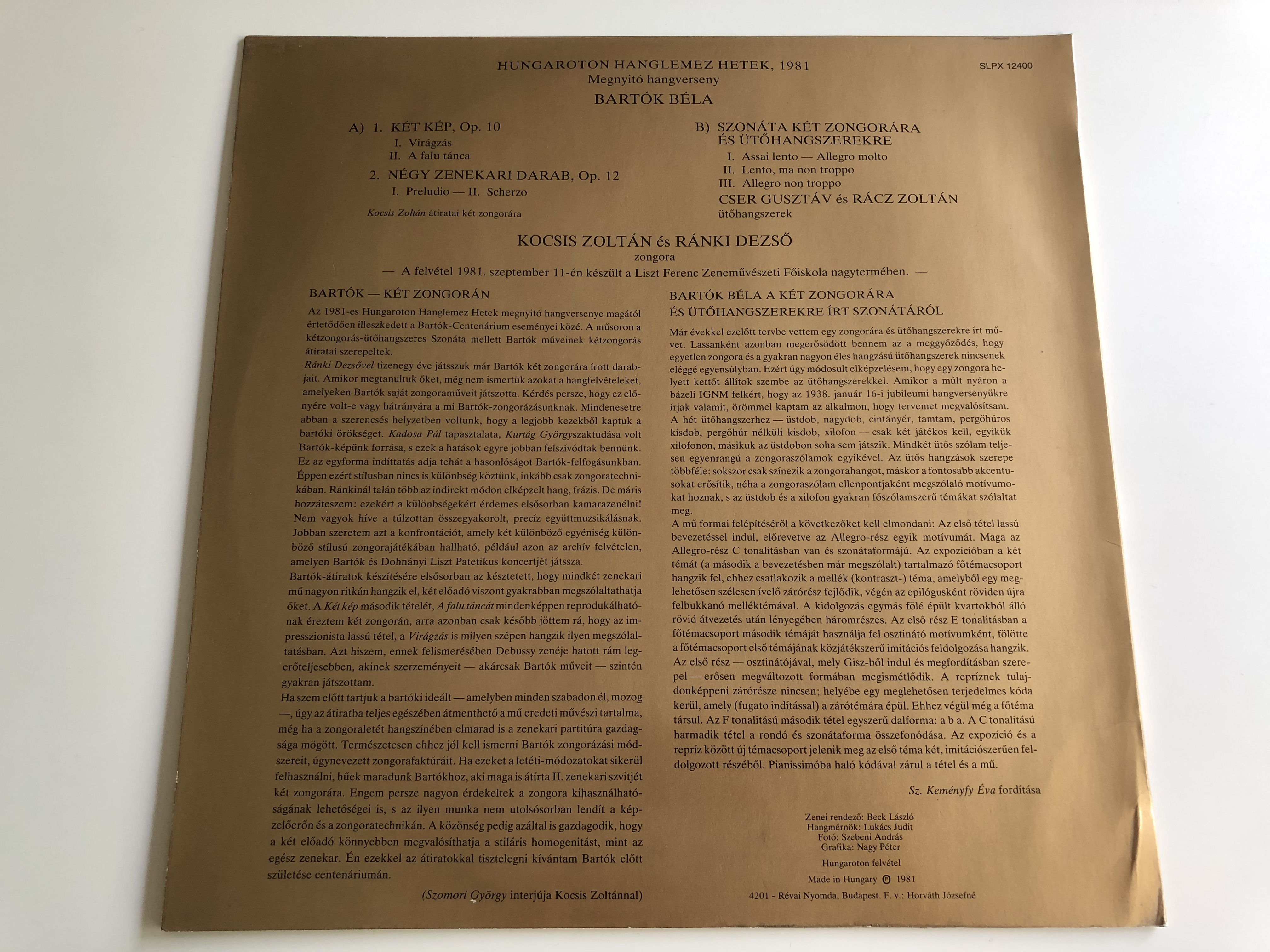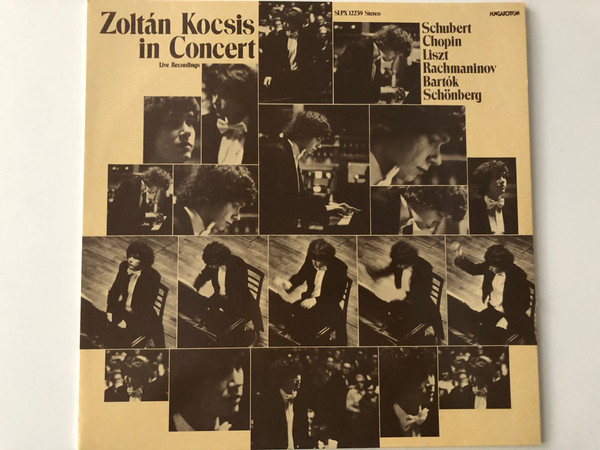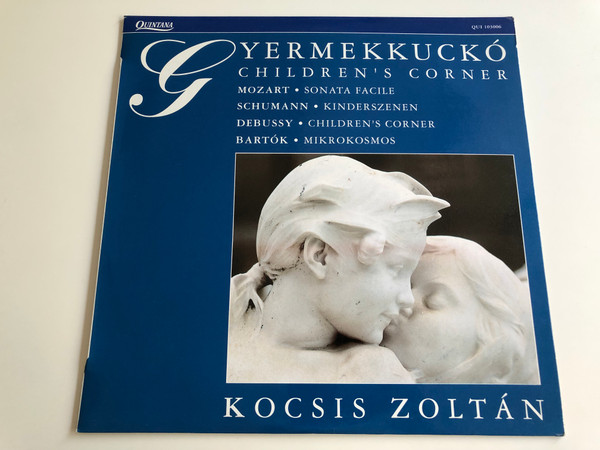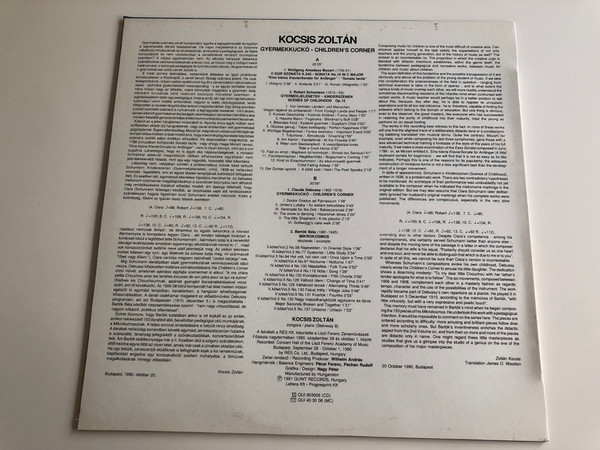Description
Hungaroton Lemez Hetek 1981 - Bartók Opening Concert / Kocsis & Ránki (Vinyl LP)
UPC:
MPN: SLPX 12400
Brand Name: Hungaroton
Overview
This historic 1981 stereo vinyl LP captures the opening concert of the Hungaroton Lemez Hetek (Hungaroton Record Weeks) festival, recorded live at the prestigious Franz Liszt Academy of Music in Budapest on September 11, 1981. The album features breathtaking performances of Béla Bartók's orchestral and chamber masterworks by two of Hungary's greatest pianists—Zoltán Kocsis and Dezső Ránki. The program includes Bartók's evocative "Two Pictures, Op. 10" ("Virágzás" / "In Full Flower" and "A falu tánca" / "Village Dance"), the dramatic "Four Orchestral Pieces, Op. 12," and the monumental "Sonata for Two Pianos and Percussion," one of the most innovative and challenging works in the 20th-century chamber music repertoire. Remarkably, Zoltán Kocsis personally transcribed the orchestral works for two pianos, demonstrating his profound understanding of Bartók's compositional language and orchestral colors. Joining Kocsis and Ránki are distinguished percussionists Gusztáv Cser and Zoltán Rácz, who bring virtuosic precision to the sonata's intricate rhythmic demands. Produced by László Beck and engineered by Judit Lukács, this recording preserves the electric atmosphere of a landmark live performance celebrating Hungary's greatest 20th-century composer. The album showcases the extraordinary musical partnership between Kocsis and Ránki, two artists whose technical brilliance and interpretive depth made them international legends. Manufactured in Hungary and pressed on high-quality vinyl, this collectible LP represents a pinnacle of Hungarian classical music recording during the late Communist era.
Product Features
- Format: Vinyl LP, Stereo
- Release Year: 1981
- Label: Hungaroton
- Catalog Number: SLPX 12400
- Country of Manufacture: Hungary
- Genre: Classical
- Style: 20th Century Modern, Hungarian National School
- Composer: Béla Bartók (1881-1945)
- Recording Type: Live concert recording
- Recording Date: September 11, 1981
- Recording Venue: Franz Liszt Academy of Music (Liszt Ferenc Zeneakadémia), Budapest
- Performers: Zoltán Kocsis (piano), Dezső Ránki (piano)
- Percussionists: Gusztáv Cser, Zoltán Rácz
- Producer: László Beck
- Sound Engineer: Judit Lukács
- Transcription: Zoltán Kocsis (Two Pictures, Op. 10; Four Orchestral Pieces, Op. 12)
- Photographer: András Szebeni
- Graphic Design: Péter Nagy
- Printed By: Révai Nyomda (printing house)
- Sleeve Notes: Béla Bartók, Zoltán Kocsis
- Rights Society: Artisjus (Hungarian copyright organization)
- Condition Note: Vintage vinyl, collectible format
- Target Audience: Classical music collectors, Bartók enthusiasts, Hungarian music specialists, vintage vinyl collectors
Interesting Facts
This album documents a historic moment in Hungarian cultural life—the opening concert of the 1981 Hungaroton Lemez Hetek (Hungaroton Record Weeks), an important annual festival celebrating Hungarian classical music and the nation's finest performers. The festival provided rare opportunities for Hungarian audiences to experience live performances by their country's greatest artists during a period when international cultural exchange was limited by Cold War restrictions.
Béla Bartók (1881-1945) stands as one of the 20th century's most influential composers, pioneering the integration of folk music elements into classical forms and creating a distinctly Hungarian modernist voice. His "Two Pictures, Op. 10" (1910) and "Four Orchestral Pieces, Op. 12" (1912) represent his early maturity, when he was absorbing influences from French Impressionism (particularly Debussy) while developing his unique harmonic language rooted in Hungarian and Romanian folk traditions. The "Sonata for Two Pianos and Percussion" (1937), composed during Bartók's late Hungarian period before his emigration to America, is considered one of his greatest chamber works—a tour de force combining percussive piano writing with intricate rhythmic interplay between timpani, xylophone, snare drums, cymbals, and other percussion instruments.
Zoltán Kocsis (1952-2016) was one of the greatest pianists of his generation and a towering figure in Hungarian musical life. Beyond his legendary performing career, Kocsis was an accomplished conductor, composer, and transcriber. His transcriptions of Bartók's orchestral works for two pianos on this album represent serious musical scholarship, requiring intimate knowledge of orchestration, harmonic structure, and idiomatic piano writing. Kocsis not only understood Bartók's orchestral colors intellectually but possessed the pianistic genius to translate them convincingly to the keyboard, creating transcriptions that are both faithful to the originals and effective as piano works in their own right.
Dezső Ránki (born 1951) achieved international fame after winning the 1969 Zoltán Kodály Competition and the 1973 Schumann International Competition. He and Kocsis formed one of the most celebrated two-piano partnerships in classical music history, combining complementary temperaments—Kocsis's intellectual rigor and structural clarity with Ránki's lyrical warmth and spontaneous expressiveness. Their musical chemistry is palpable throughout this recording, particularly in the Sonata for Two Pianos and Percussion, where they navigate Bartók's complex contrapuntal textures and challenging ensemble coordination with telepathic understanding.
The Franz Liszt Academy of Music, where this concert was recorded, is Hungary's most prestigious music conservatory, founded in 1875 by Franz Liszt himself. Its main concert hall, completed in 1907, is renowned for its exceptional acoustics and breathtaking Art Nouveau interior. Recording live in this venerable space captured not only the performances but the unique ambiance of one of Europe's great musical landmarks.
Hungaroton, founded in 1951 as Hungary's state-owned record label, became internationally respected for documenting Hungarian classical music with technical excellence. The label recorded virtually every important Hungarian performer and composer during the Communist era, creating an invaluable archive of Eastern European musical culture. This 1981 recording exemplifies Hungaroton's commitment to capturing significant live events with broadcast-quality sound engineering.
The album's production credits reveal the collaborative nature of Hungarian arts production during this period. Engineer Judit Lukács, producer László Beck, photographer András Szebeni, and graphic designer Péter Nagy were all important figures in Hungary's cultural infrastructure. The printing was handled by Révai Nyomda, one of Hungary's historic printing houses. The rights are administered by Artisjus, the Hungarian copyright society founded in 1907, which protected composers' and performers' rights even during the Communist period.
The sleeve notes by Bartók himself (likely excerpts from his writings or program notes) and Kocsis provide scholarly context for understanding these works, reflecting the educational mission that Hungarian classical music institutions maintained even during politically restrictive times. This LP represents not just a musical document but a snapshot of Hungarian cultural life at a specific historical moment—when the nation's artistic traditions continued to flourish despite political constraints, and when two extraordinary pianists were at the height of their collaborative powers, honoring their country's greatest composer.
Complete Track Listing
Side A:
Two Pictures, Op. 10 (Két Kép, Op. 10) - Transcribed for two pianos by Zoltán Kocsis
- A1. Virágzás (In Full Flower)
- A2. A Falu Tánca (Village Dance)
Four Orchestral Pieces, Op. 12 (Négy Zenekari Darab, Op. 12) - Transcribed for two pianos by Zoltán Kocsis
- A3. I. Preludio - II. Scherzo
Side B:
Sonata for Two Pianos and Percussion (Szonáta Két Zongorára És Ütőhangszerekre)
- B1. Assai Lento -- Allegro Molto
- B2. Lento, Ma Non Troppo
- B3. Allegro Non Troppo
- B4. A Falu Tánca / Village Dance
Credits
Composed By: Béla Bartók (1881-1945)
Piano: Zoltán Kocsis, Dezső Ránki
Percussion: Gusztáv Cser (tracks B1-B3), Zoltán Rácz (tracks B1-B3)
Transcription By: Zoltán Kocsis (tracks A1-A3)
Producer: László Beck
Sound Engineer: Judit Lukács
Photography By: András Szebeni
Graphics: Péter Nagy
Sleeve Notes: Béla Bartók, Zoltán Kocsis
Printed By: Révai Nyomda
Rights Society: Artisjus
Recording Details:
Recorded live at the Franz Liszt Academy of Music (Liszt Ferenc Zeneakadémia), Budapest, Hungary
September 11, 1981
Publisher
Hungaroton
Catalog Number: SLPX 12400
Budapest, Hungary
Released: 1981
Manufactured in Hungary
We value your feedback! Share your experience with this product to help others make informed decisions. Your review is important to us!
#BartokRecording #ZoltanKocsis #DeszoRanki #HungarotonVinyl #1981LiveRecording #HungarianClassical #LisztAcademy #TwoPianosSonata #BartokSonata #VintageVinyl #ClassicalVinylLP #HungarianMusic #20thCenturyClassical #LiveConcertRecording #CollectibleVinyl #KocsisRanki #BartokOrchestral #PianoTranscriptions #HungarianPianists #ClassicalMusicHungary #RareVinylRecords #BuyClassicalVinylOnline #BartokChamberMusic #StereoVinyl #CommunistEraRecording #EasternEuropeanClassical #VintageHungaroton #HistoricRecording #PianoPercussionSonata #BudapestRecording









